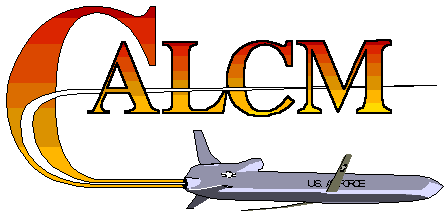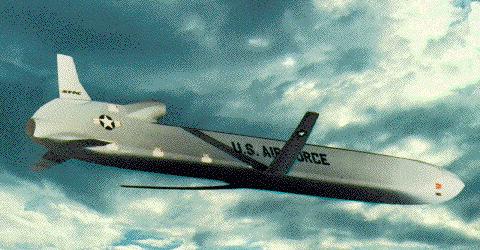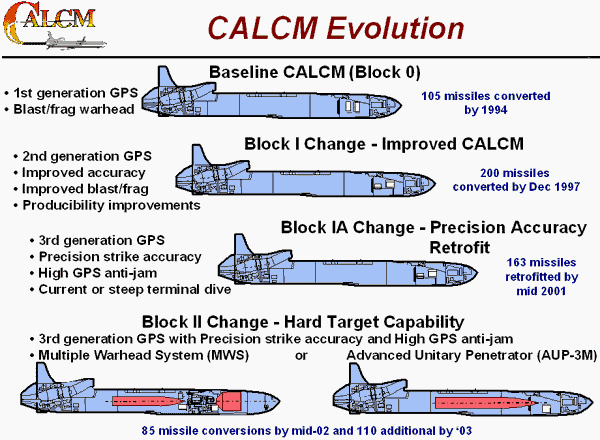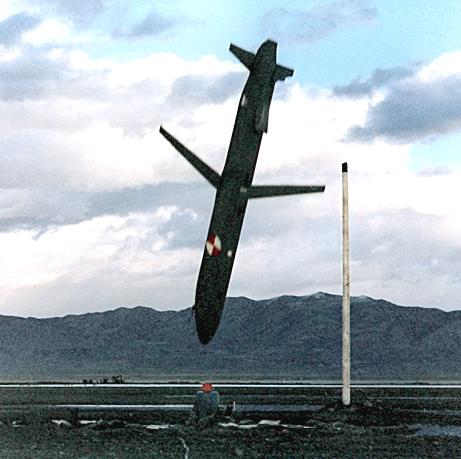AGM-86C/D Conventional Air Launched Cruise Missile

The AGM-86C Conventional Air Launched Cruise Missile (CALCM) was developed to increase the effectiveness of B-52H bombers, dilute an enemy's forces, and complicate the defense of enemy territory.
The small, winged AGM-86C CALCM is powered by a turbofan jet engine that propels it at sustained subsonic speeds. After launch, the missile's folded wings, tail surfaces and engine inlet deploy. It then is able to fly complicated routes to a target through the use of an onboard Global Positioning System (GPS) coupled with its Inertial Navigation System (INS). This allows the missile to guide itself to the target with pinpoint accuracy.
The AGM-86C CALCM increases the Air Force's flexibility in target selection. The B-52H is capable of carrying six CALCMs on each of two externally mounted pylons and eight internally on a rotary launcher, giving the B-52H a maximum capacity of 20 CALCMs per aircraft. The AGM-86C CALCM differs from the AGM-86B Air Launched Cruise Missile (ALCM) in that it carries a conventional blast/frag payload rather than a nuclear payload and employs a GPS aided INS.
An enemy force would have to counterattack each of the missiles, making defense against them costly and complicated. The enemy's defenses are further hampered by the missile's small size and low-altitude flight capability, which also makes them difficult to detect on radar.

In February 1974, the Air Force entered into contract to develop and flight-test the prototype AGM-86A ALCM, which was slightly smaller than the later B and C models. The 86A model did not go into production. Instead, in January 1977, the Air Force began full-scale development of the AGM-86B ALCM, which greatly enhanced the B-52's capabilities and helped America maintain a strategic deterrent.
Production of the initial 225 AGM-86B ALCMs began in fiscal year 1980 and production of a total 1,715 missiles was completed in October 1986. The ALCM became operational four years earlier, in December 1982, with the 416th Bombardment Wing at Griffiss Air Force Base, NY, which deactivated when the base closed in 1995.
In June 1986, a limited number of AGM-86B ALCMs were converted to carry a high-explosive blast/fragmentation warhead and an internal GPS. They were redesignated as the AGM-86C CALCM. This modification replaced the AGM-86B ALCM's terrain contour-matching guidance system and integrated a GPS with the existing INS. This ALCM to CALCM modification program was conducted under under classified contract F34601-91-C-1156, which delivered the last lot of AGM-86C's to the Air Force in June 1993.
The CALCM became operational in January 1991 at the onset of Operation DESERT STORM. Seven B-52Hs carrying a total of 39 CALCMs flew nonstop round-trip from Barksdale AFB, LA to designated launch points in the U.S. Central Command's area of responsibility. At these points, 35 missiles were launched to attack high-priority targets in Iraq. These missions marked the beginning of the air campaign for Kuwait's liberation and are the longest known aircraft combat sorties in history (more than 14,000 miles and 35 hours of flight).CALCM was subsequently employmd on 3 September 1996 in Operation DESERT STRIKE. In response to Iraq's continued hostilities against the Kurds in northern Iraq, the Air Force launched 13 CALCMs in a joint attack with the Navy. This mission put the CALCM program in the spotlight and helped propel the research and development of a multiple warhead penetrator version of the CALCM called the AGM-86D (Block II). CALCM was most recent employment occurred in December 199 in Operation DESERT FOX.

Block 0/I missiles are being retrofitted to Block IA with a precision accuracy kit that uses a third generation GPS receiver along with advanced navigation software, and a GPS anti-jam electronics module and antenna for a significant increase in jamming immunity. The contract for Block IA was awarded in April 1998 with initial kit deliveries scheduled for July 2000. Under the development and production contract, Boeing will develop and deliver 28 missile retrofit kits to the Air Force, which will complete the missile kit installation. Major kit components include the GPS Receiver Interface Unit/Precision (GRIU/P) built by Interstate Electronics Corporation; a GPS anti-jam module built by Harris; and a four element GPS antenna array based on the design by Boeing Phantom Works. To increase CALCM effectiveness against a wider spectrum of targets, a capability for shallow to near-vertical dive angles from any approach reference point also is being integrated. Flight software improvements include a large-state Kalman filter for optimizing GPS accuracy, to include code and phase measurement data, pressure and temperature measurements, and wide-area GPS enhancement to reduce system errors.
The AGM-86D Block II program is the Precision Strike variant of CALCM. It incorporates a penetrating warhead, updated state of the art, near-precision, GPS guidance, and a modified terminal area flight profile to maximize the effectiveness of the warhead. The penetrating warhead is augmented with two forward shape charges. To maximize the warheads effectiveness against hardened targets, the Block II will maneuver and dive onto its target in a near vertical orientation. The updated guidance system will increase the systems lethality by obtaining a less than 5 meter CEP. The Precision Strike variant of CALCM was successfully demonstrated in December 1996. A CALCM modified with a new precision GPS implementation flew for 4.5 hours, performed a newly developed steep terminal dive, and impacted the target within 2.5 meters of the aim point. The demonstration clearly showed that CALCM is capable of delivering it�s warhead with precision accuracy from extremely long standoff ranges. A feasibility study was concluded in April 1997, in which it was determined the BROACH Warhead on CALCM would offer very significant hard target capabilities. Foreign Comparative Test (FCT) funds have been provided by DoD for a demonstration of the UK�s BROACH Warhead. The FCT concluded in late 1998. In October 1997 British Aerospace announced that Aerojet had been selected as its US partner in TEAM BROACH for product engineering and integration of the BROACH warhead system into US weapons.The BROACH multi-warhead system, also under evaluation for the the Joint Stand-off Weapon (JSOW), achieves its results by combining an initial penetrator charge (warhead) with a secondary follow-through bomb, supported by multi-event hard target fuzing. The outcome is a warhead and fuze combination that provides for the defeat of hardened targets more than twice that achievable for equivalent single penetrating warhead types, at an equivalent weight and velocity. The warhead technology can be scaled and configured for a variety of weapon payload and targets requirements The current Block II program is structured for EMD to begin in first quarter FY99 with missile production to commence in third quarter FY00. Total procurement is for between 130 and 195 missiles.
Specifications |
||||
| Primary Function: | Air-to-ground strategic cruise missile | |||
| Contractor: | Boeing Defense & Space Group Aerojet - CALCM warhead |
|||
| Guidance Contractors: | Litton Guidance & Control, Rockwell Collins Avionics, and Interstate Electronics Corp. | |||
| Power Plant: | Williams International Corp. F-107-WR-101 turbofan engine | |||
| Thrust: | 600 pounds | |||
| Length: | 20 feet, 9 inches | |||
| Weight: | 3,250 pounds | |||
| Diameter: | 24.5 inches | |||
| Wingspan: | 12 feet | |||
| Range: | Nominal: 600nm Specific: Classified | |||
| Speed: | Nominal: High Subsonic Specific: Classified | |||
| Guidance System: | Litton Inertial Navigation Element integrated with an onboard Global Positioning System | |||
| VARIANTS | AGM-86C Block 0 | AGM-86C Block I | AGM-86C Block IA | AGM-86D Block II |
| Warhead: |
1,500-lb AFX-760 Blast Fragmentation Warhead |
3,000-lb PBXN-111 Blast Fragmentation Warhead | Penetrating Warhead | |
| Initial Operational Capability: | Jun 1986 | Jul 1996 | Jul 2000 | mid-2002 |
| Full Operational Capability: | Jun 1993 | Dec 1997 | 2001 | 2003 |
| Total Production: | 105 | 200 | 163 | 130 - 195 |
| Combat Expenditure: | 39 + 13 | |||
| Current Inventory: | -50 | ~200 | 0 | 0 |
| Unit Cost: | $150K conversion cost | |||
Sources and Resources
- CALCM - Cruise Missile Product Group (CMPG) @ Tinker AFB
- CALCM @ Boeing



